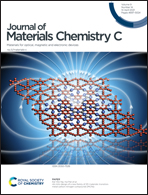One-electron reduction induced spin transition in Fe(ii) spin crossover molecules and the effect of the ligand†
Abstract
Recent experiments reported voltage-controlled transitions from low spin to high spin in molecular junctions of spin crossover molecules, which could bring higher performance for related electronic devices. As for the mechanism, the voltage-controlled spin transition was probably attributed to the one-electron reduction of spin crossover molecules, and the (p–d)π bonding between the ligand and metal was regarded as the key factor for the reduction-induced spin transition. In this work, spin crossover molecules FeII[H2B(Pz)2]2(L) are taken as examples to explore the effect of the ligand on the (p–d)π bonding and the reduction-induced spin transition, based on density functional theory. Interestingly, when the number of aromatic rings increases in the L ligand the (p–d)π bonding generally grows weaker and even ignorable, which shows that the ligand can have a significant impact on the reduction-induced spin transition. If reduction is not obtained, the low spin configuration is, however, little influenced by the increase of the aromatic rings. We also quantify the effect of the (p–d)π bonding on the spin transition using energy decomposition analysis. Our study provides an important guide for design of functional materials and molecular devices using spin crossover molecules.



 Please wait while we load your content...
Please wait while we load your content...